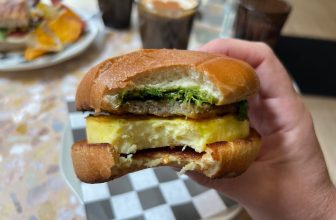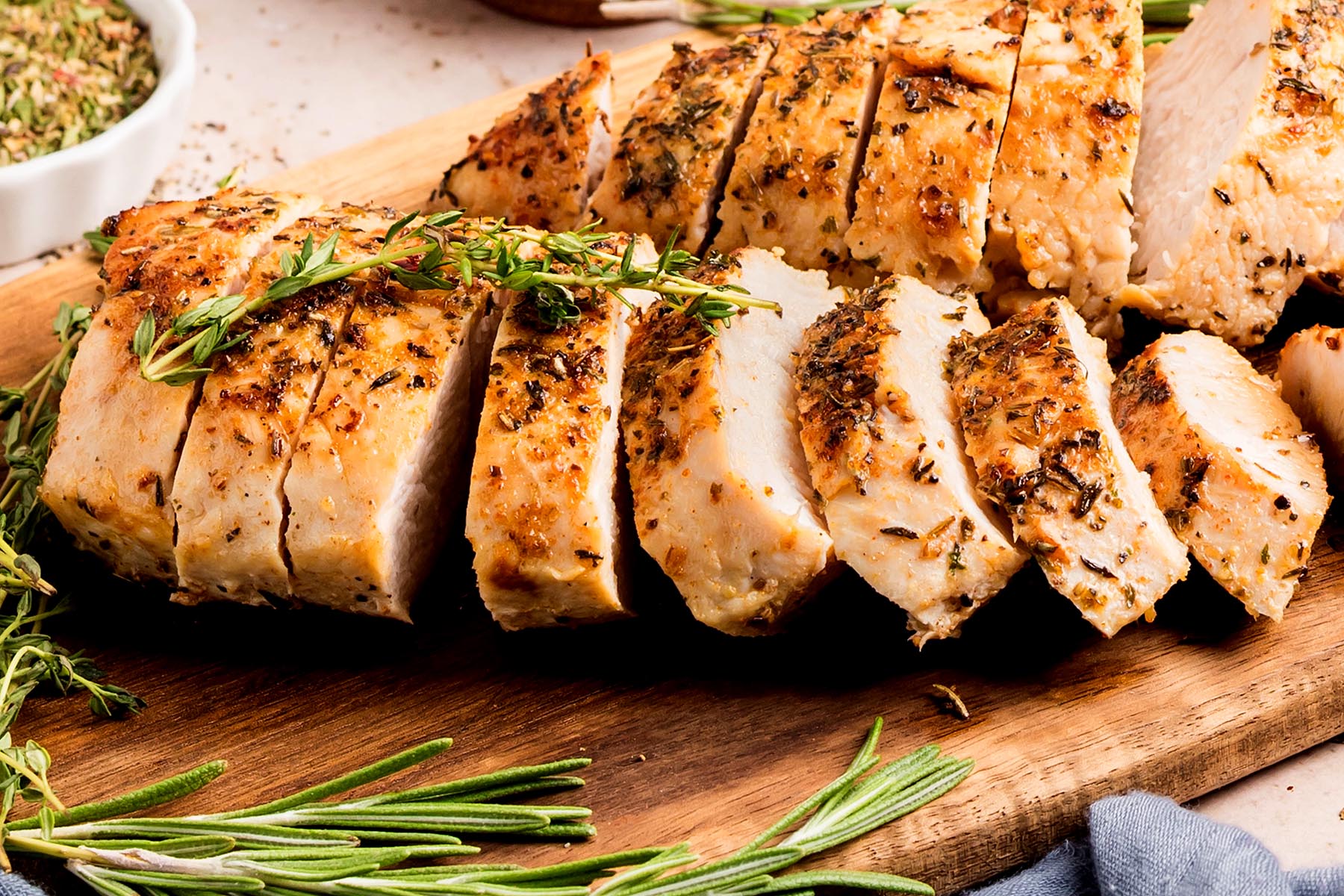
Herb-seasoned, oven-roasted turkey tenderloins stay ultra-juicy, and a touch of honey balances the savory flavors. This is the only turkey I make for Thanksgiving now.


Juicy, herb-rubbed oven-roasted turkey tenderloins with a quick skillet sear, a honey glaze, and a clean roast. It’s a simple technique that delivers big flavor and is slice-perfect every time. It’s the kind of main course that feels special enough for company but stays weeknight-practical because it cooks quickly. It requires minimal prep and uses pantry staples. It’s great for dinner but also works well for meal prep for lunch sandwiches and salads.
If you’re hosting a small-gathering (or an easy holiday dinner without roasting a whole bird), pair these tenderloins with a few of our favorite, make-ahead friendly sides. Try my roasted butternut squash, garlic Parmesan rice, truffle mashed potatoes, or simple oven-roasted potatoes. Add a tossed salad or steamed green veg and you’re set.
I’m sure you will love this one!
What Makes These Tenderloins Special
Ingredients at a Glance


- Turkey Breast Tenderloins. Boneless, skinless strips from the breast that cook fast and stay tender. If yours are thinner, start checking for doneness early. If you can’t find tenderloins, use thick turkey cutlets and reduce oven time, or use small chicken breasts and cook to 165 F (74 C).
- Avocado Oil. Avocado oil has a high smoke point for a clean sear. Canola or grapeseed work the same. Olive oil is fine in a pinch. Just keep the skillet at medium so it doesn’t smoke.
- Italian Seasoning. An all-in-one herb blend for simplicity and flavor. You can swap in herbes de Provence or mix equal parts dried thyme and rosemary if that’s what you have.
- Paprika. For color and warmth. Swapping in smoked paprika adds a smoky flavor.
- Coarse Kosher Salt. For seasoning and moisture. You can swap table salt but use less.
- Black Pepper. Freshly ground if possible. White pepper works for milder flavor.
- Garlic and Onion Powder. Garlic and onion powder provide the perfect touch of garlic and onion flavor. You can sub 1 small fresh garlic clove finely grated and 1 tablespoon very finely minced onion, but powders brown more evenly during the sear.
- Dried Thyme and Rosemary. These are classic poultry herbs. If you’re out, add a bit more Italian seasoning and some poultry seasoning if you have it. You can also finish with chopped fresh thyme/rosemary after slicing.
- Honey. A light glaze that balances the savory herbs. Maple syrup is a great swap.
How to Make It (Photo Tutorial)
Step 1: Preheat the oven to 400 F (200 C) with the rack centered. Pat the turkey tenderloins very dry and trim any silver skin or loose membranes.


Step 3: Heat a cast-iron skillet over medium to medium-high, then sear the seasoned tenderloins 2–3 minutes per side until golden brown. Just color, not cooked through.


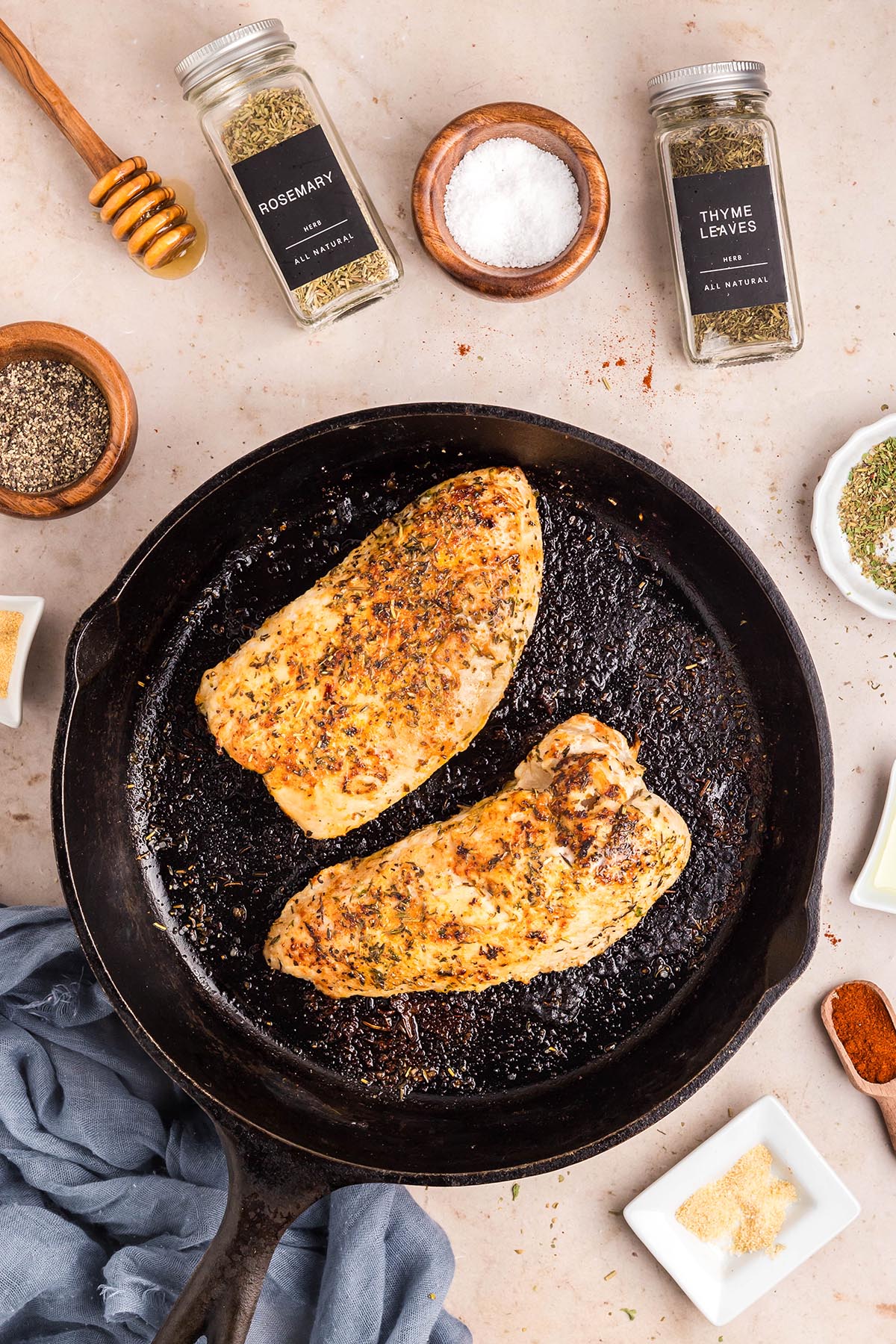

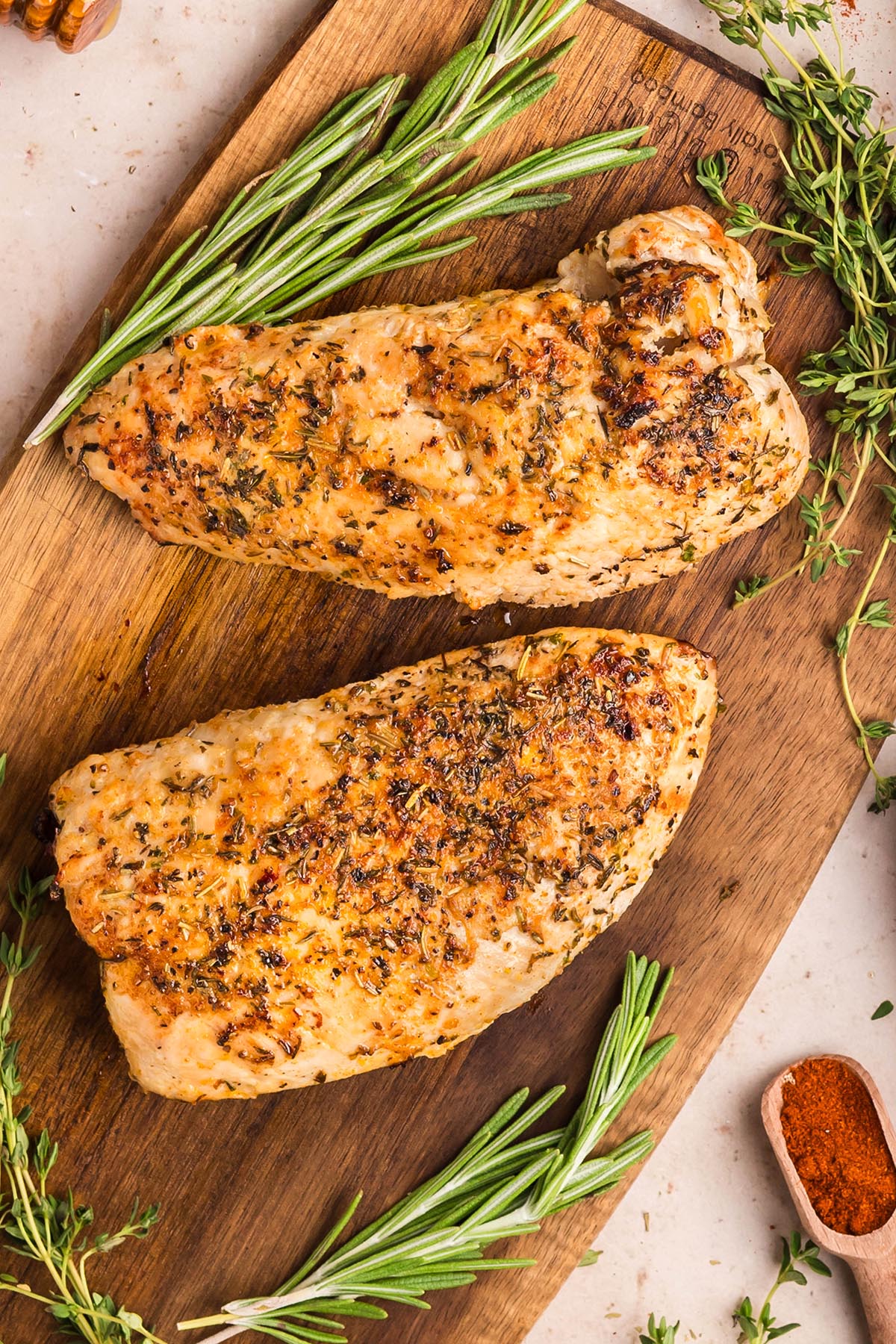

Tips for Success
- Pat Dry. Surface moisture prevents browning. Blot well before oiling and seasoning.
- Preheat the Pan, Then Don’t Fuss. Heat cast iron over medium to medium-high, then sear 2–3 minutes per side. Resist moving the meat until a crust forms.
- Honey Only on Top. Drizzle honey over the tops just before roasting. It caramelizes beautifully without scorching the pan side. Be sure to add it before placing it in the oven, not while searing.
- Cook by Temperature, not Time. Start checking internal temp at 12 minutes. Pull the tenderloins out at 160–162 F (71–72 C) and rest to 165 F (74 C). If not there, keep roasting and check every 3–5 minutes.
- Thickness Matters. Thinner pieces reach temp faster. If one tenderloin is smaller, remove it to rest while the thicker one finishes.
- Rest Equals Juicy Slices. Immediately move to a board and rest 10 minutes before slicing across the grain.
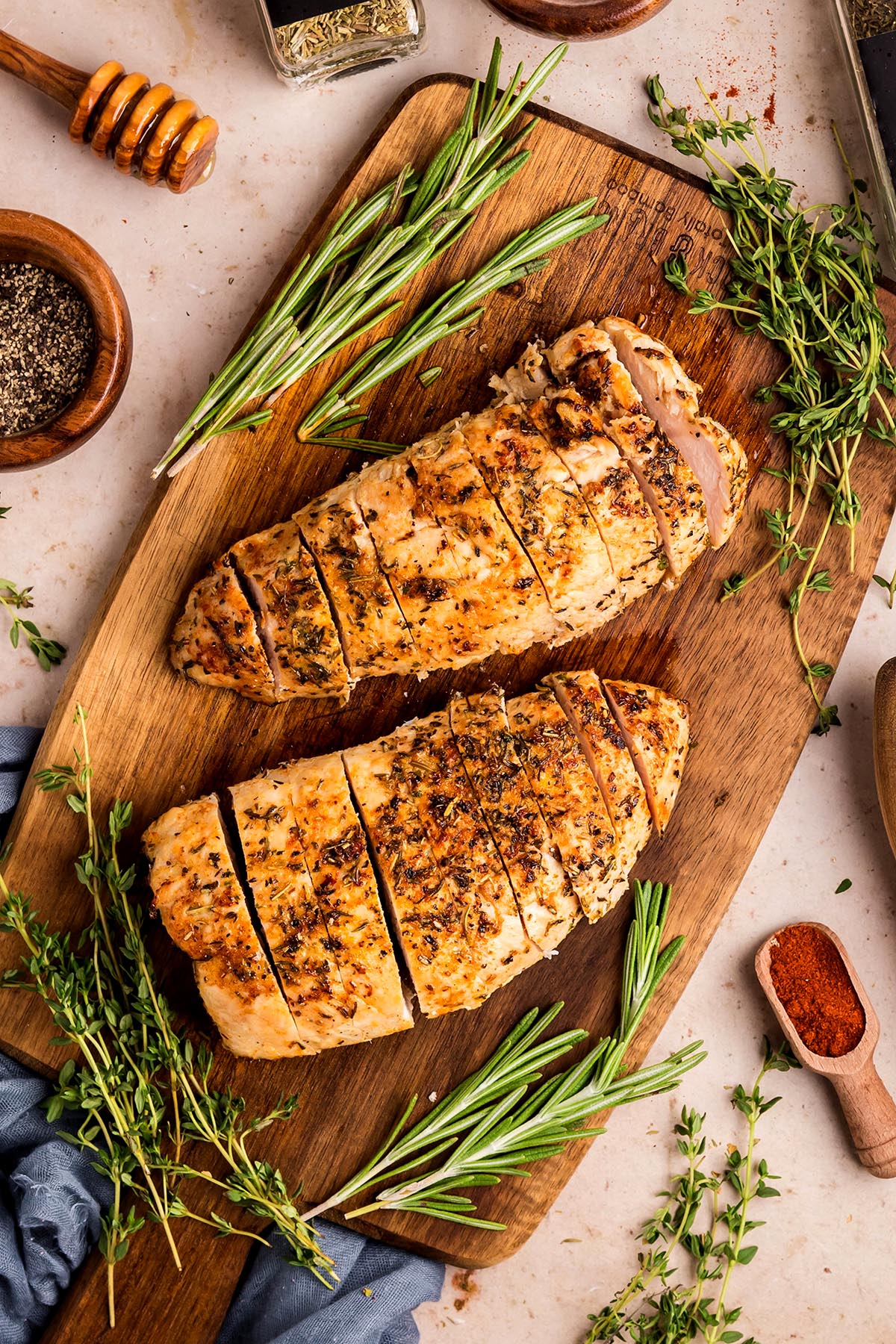

How to Serve It
- Classic Dinner. Fan the slices and spoon over any pan juices. Add sides like garlic butter mushrooms, dill roasted potatoes, harissa roasted cauliflower, autumn pasta salad, rosemary biscuits, or garlic rosemary potatoes.
- Thin-Slice for Sandwiches. Chill briefly for cleaner cuts, slice very thin, and layer on crusty bread with Dijon or herb-mayo, lettuce, and pickled onions. Toast into a melt with provolone or Swiss.
- Grain Bowls. Pile over warm rice or quinoa with roasted veggies (squash, carrots, broccoli), a drizzle of olive oil or vinaigrette, lemon, and a pinch of flaky salt.
- Big Salad. Toss slices with mixed greens, roasted squash, dried cranberries, toasted pecans, and a simple vinaigrette.
- Quick Pan Sauce. While the turkey rests, add a few tablespoons of broth into the hot skillet, reduce 1–2 minutes, and spoon over slices for a simple sauce.
- Open-Face Sandwich. Serve on thick toast or garlic bread with a light gravy or jus and some fresh herbs sprinkled over the top.
- Leftover Makeover. Dice for a next-day fried rice, noodles, or a turkey-veggie hash with eggs. It would also be great in this one pan mushroom pasta.
Storage and Reheating
Cool & store
- Let the turkey cool slightly, then refrigerate within 2 hours of cooking.
- For the best results, store larger pieces or whole tenderloins (then slice after reheating).
- Pack airtight with any juices. Keeps 3–4 days in the fridge.
Freezing
- Wrap slices or whole tenderloins tightly (plastic plus a freezer bag).
- Freeze up to 2–3 months.
- Thaw overnight in the fridge for the best quality. If needed, do a quick, sealed-bag thaw in cold water, changing the water every 30 minutes.
Best Ways to Reheat (Choose One)
- Oven (most even): Place turkey in a small baking dish with 1–2 tablespoons broth per serving. Cover tightly and warm at 275 F (135 C) until heated through (about 10–20 minutes, depending on the thickness). Optional: uncover for the last 2–3 minutes.
- Covered skillet (fast): Add 1–2 tablespoons broth per serving to a skillet. Add turkey, cover, and warm on low 4–8 minutes. Rest 1 minute before serving.
- Microwave (fastest): Arrange slices in a single layer with a spoonful of broth, cover (microwave-safe lid), and heat at 50% power in short bursts until hot. Let stand 1 minute.
Pro Reheating Tips for Juicy Results
- Slice after reheating when possible. Whole pieces retain moisture better.
- If reheating already-sliced turkey, stack slices slightly overlapping and add a spoon of broth before covering.
- For a touch of shine, brush a melted butter or a few drops of olive oil/honey-broth over hot slices right before serving.
- Avoid reheating uncovered on high heat. This will cause the turkey breast to dry out quickly. Also avoid reheating multiple times. Warm only what you’ll eat.
Try These Next
Did you try these oven-roasted turkey tenderloins? I’d love to hear how it went! Leave a comment and a star rating below, and tell me what you served on the side (roasted butternut squash? garlic Parmesan rice?). Your feedback helps other readers and keeps this recipe the best it can be.


- 24 oz turkey breast tenderloins usually two pieces (Note 3)
- 1 teaspoon Italian seasoning
- ½ teaspoon paprika
- ½ teaspoon coarse kosher salt (Note 5)
- ½ teaspoon black pepper
- ½ teaspoon garlic powder
- ½ teaspoon onion powder
- ½ teaspoon dried thyme
- ½ teaspoon dried rosemary crushed between fingers
- 1 tablespoon avocado oil (Note 4)
- 1 teaspoon honey
-
Preheat the oven to 400 F (200 C) with a rack in the center. (Note 6)Pat the 24 oz turkey breast tenderloins very dry with paper towels. Trim any silver skin or loose membrane if present. (see Note 3)
-
In a small bowl, mix 1 teaspoon Italian seasoning, ½ teaspoon paprika, ½ teaspoon coarse kosher salt, ½ teaspoon black pepper, ½ teaspoon garlic powder, ½ teaspoon onion powder, ½ teaspoon dried thyme, and ½ teaspoon dried rosemary. Rub the turkey all over with 1 tablespoon avocado oil, then sprinkle the spice blend evenly on all sides, pressing to adhere. (see Note 7)
-
Heat the cast-iron skillet over medium to medium-high, about 2 minutes. Add the seasoned tenderloins and sear 2–3 minutes per side until golden-brown. Do not cook through here. You just want a little color. (see Note 4)
-
Remove the skillet from heat. Brush or drizzle the 1 teaspoon honey only on the top side of each tenderloin. (This encourages caramelization without scorching the pan side.)
-
Transfer the skillet to the oven. Roast 12–18 minutes depending on thickness (Note 8), or until the thickest part registers 160–165 F (70 to 74 C) on an instant-read thermometer. If not at temp, keep roasting and check every 3–5 minutes. (see Note 2)
-
Immediately transfer the turkey to a cutting board. (You may loosely tent with foil.) Rest 10 minutes to allow juices to redistribute. (Note 9)Slice across the grain and serve.
- Cast iron is ideal for sear-to-oven. If using stainless, preheat well and add a touch more oil. Release will happen once browning occurs. If you don’t have an oven-safe skillet, sear in a skillet, then transfer to a preheated sheet pan or small roasting pan and continue in the oven.
- USDA guidance is 165 F (74 C) for poultry. To prevent overcooking, you can pull at 160–162 F; carryover heat during the 10-minute rest typically brings it to 165 F. Always measure in the thickest center of the tenderloin, holding the tip just past the center, not touching the pan.
- This recipe is written for turkey breast tenderloins (boneless, skinless strips from the breast). They cook much faster than a whole breast. If a thin silvery membrane (silver skin) is present, slide a knife under the edge and trim. It can cause curling and chewiness. Always pat dry so seasoning adheres and searing browns instead of steams.
- Use a high-smoke-point oil (avocado, refined canola, or grapeseed). Preheat until the oil shimmers; if it smokes aggressively, reduce the heat. Don’t move the turkey for the first 2 minutes. Let the crust form. Apply honey only on the top right before roasting so it caramelizes without scorching against the skillet.
- “Coarse kosher salt” here assumes Diamond Crystal. If using Morton kosher, which is denser/saltier, use ¼–⅜ teaspoon instead of ½ teaspoon. If using table salt, use ¼ teaspoon.
- Ovens run hot or cool. If you have one, place an oven thermometer on the center rack. For convection, set to 375 F (190 C) and start checking earlier (10–15% faster).
- Flavor Variations. Swap the Italian seasoning for herbes de Provence if you’d like a different flavor profile. Add ¼ teaspoon smoked paprika for subtle smoky flavor. Replace honey with maple syrup.
- Tenderloin thickness varies. Use this as a guide, always confirming with a thermometer:
1 inch thick: 12–14 minutes after sear
1¼ inches: 14–17 minutes
1½ inches: 17–20 minutes
1¾ inches: 20–23 minutes
If the two pieces are uneven, start checking the smaller one first and remove it to rest while the thicker one finishes. - Resting is non-negotiable. It keeps juices in the meat, not on your board. A loose foil tent keeps the surface warm without steaming the crust. Slice across the grain into ½-inch slices.
Cooling and Reheating
Cool, then store slices airtight 3–4 days in the fridge. Reheat gently: place slices with a tablespoon of broth in a covered skillet over low heat until warmed through, or cover and warm at 275 F (135 C) in the oven. Avoid microwaving on high as it dries out poultry.
Calories: 223kcal | Carbohydrates: 3g | Protein: 40g | Fat: 6g | Saturated Fat: 1g | Polyunsaturated Fat: 0.5g | Monounsaturated Fat: 2g | Cholesterol: 76mg | Sodium: 405mg | Potassium: 20mg | Fiber: 0.4g | Sugar: 2g | Vitamin A: 34IU | Vitamin C: 1mg | Calcium: 13mg | Iron: 0.4mg
Servings: 4 servings
Calories: 223kcal






